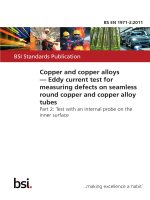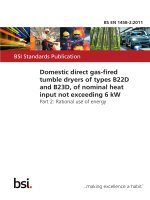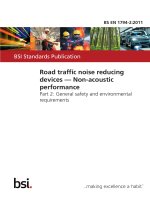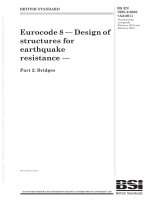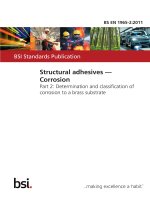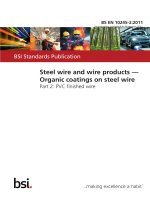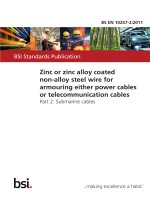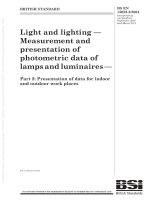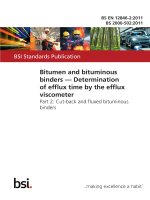Bsi bs en 61951 2 2011
Bạn đang xem bản rút gọn của tài liệu. Xem và tải ngay bản đầy đủ của tài liệu tại đây (1.36 MB, 36 trang )
BS EN 61951-2:2011
BSI Standards Publication
Secondary cells and batteries
containing alkaline or other
non-acid electrolytes —
Portable sealed rechargeable
single cells
Part 2: Nickel-metal hydride
BRITISH STANDARD
BS EN 61951-2:2011
National foreword
This British Standard is the UK implementation of EN 61951-2:2011. It is
identical to IEC 61951-2:2011. It supersedes BS EN 61951-2:2003 which
will be withdrawn on 29th June 2014.
The UK participation in its preparation was entrusted by Technical Committee
PEL/21, Secondary cells and batteries, to Subcommittee PEL/21/1, Secondary
cells and batteries containing alkaline and other non-acidic electrolytes.
A list of organizations represented on this committee can be obtained on
request to its secretary.
This publication does not purport to include all the necessary provisions of a
contract. Users are responsible for its correct application.
© BSI 2011
ISBN 978 0 580 57918 9
ICS 29.220.30
Compliance with a British Standard cannot confer immunity from
legal obligations.
This British Standard was published under the authority of the Standards
Policy and Strategy Committee on 31 August 2011.
Amendments issued since publication
Amd. No.
Date
Text affected
BS EN 61951-2:2011
EUROPEAN STANDARD
EN 61951-2
NORME EUROPÉENNE
July 2011
EUROPÄISCHE NORM
ICS 29.220.30
Supersedes EN 61951-2:2003
English version
Secondary cells and batteries containing alkaline or other non-acid
electrolytes Portable sealed rechargeable single cells Part 2: Nickel-metal hydride
(IEC 61951-2:2011)
Accumulateurs alcalins et autres
accumulateurs à électrolyte non acide Accumulateurs individuels portables
étanches Partie 2: Nickel-métal hydrure
(CEI 61951-2:2011)
Akkumulatoren und Batterien mit
alkalischem oder anderen
nichtsäurehaltigen Elektrolyten Tragbare wiederaufladbare gasdichte
Einzelzellen Teil 2: Nickel-Metallhydrid
(IEC 61951-2:2011)
This European Standard was approved by CENELEC on 2011-06-29. CENELEC members are bound to comply
with the CEN/CENELEC Internal Regulations which stipulate the conditions for giving this European Standard
the status of a national standard without any alteration.
Up-to-date lists and bibliographical references concerning such national standards may be obtained on
application to the Central Secretariat or to any CENELEC member.
This European Standard exists in three official versions (English, French, German). A version in any other
language made by translation under the responsibility of a CENELEC member into its own language and notified
to the Central Secretariat has the same status as the official versions.
CENELEC members are the national electrotechnical committees of Austria, Belgium, Bulgaria, Croatia, Cyprus,
the Czech Republic, Denmark, Estonia, Finland, France, Germany, Greece, Hungary, Iceland, Ireland, Italy,
Latvia, Lithuania, Luxembourg, Malta, the Netherlands, Norway, Poland, Portugal, Romania, Slovakia, Slovenia,
Spain, Sweden, Switzerland and the United Kingdom.
CENELEC
European Committee for Electrotechnical Standardization
Comité Européen de Normalisation Electrotechnique
Europäisches Komitee für Elektrotechnische Normung
Management Centre: Avenue Marnix 17, B - 1000 Brussels
© 2011 CENELEC -
All rights of exploitation in any form and by any means reserved worldwide for CENELEC members.
Ref. No. EN 61951-2:2011 E
BS EN 61951-2:2011
EN 61951-2:2011
-2-
Foreword
The text of document 21A/484/FDIS, future edition 3 of IEC 61951-2, prepared by SC 21A, Secondary
cells and batteries containing alkaline or other non-acid electrolytes, of IEC TC 21, Secondary cells and
batteries, was submitted to the IEC-CENELEC parallel vote and was approved by CENELEC as
EN 61951-2 on 2011-06-29.
This European Standard supersedes EN 61951-2:2003.
EN 61951-2:2011 includes the following significant technical changes with respect to EN 61951-2:2003:
— Clause 4: addition of 2 parameters;
— Clause 5: addition of cells type “S” and cells type “T”;
— Subclause 6.1.2: addition of new cylindrical cells;
— Subclause 7.8: addition of a specific test for “S” cells.
Attention is drawn to the possibility that some of the elements of this document may be the subject of
patent rights. CEN and CENELEC shall not be held responsible for identifying any or all such patent
rights.
The following dates were fixed:
– latest date by which the EN has to be implemented
at national level by publication of an identical
national standard or by endorsement
(dop)
2012-03-29
– latest date by which the national standards conflicting
with the EN have to be withdrawn
(dow)
2014-06-29
Annex ZA has been added by CENELEC.
__________
Endorsement notice
The text of the International Standard IEC 61951-2:2011 was approved by CENELEC as a European
Standard without any modification.
In the official version, for Bibliography, the following notes have to be added for the standards indicated:
IEC 60051 series
NOTE Harmonized in EN 60051 series.
IEC 61434
NOTE Harmonized as EN 61434.
__________
BS EN 61951-2:2011
-3-
EN 61951-2:2011
Annex ZA
(normative)
Normative references to international publications
with their corresponding European publications
The following referenced documents are indispensable for the application of this document. For dated
references, only the edition cited applies. For undated references, the latest edition of the referenced
document (including any amendments) applies.
NOTE When an international publication has been modified by common modifications, indicated by (mod), the relevant EN/HD
applies.
Publication
Year
Title
EN/HD
Year
IEC 60050-482
-
International Electrotechnical Vocabulary Part 482: Primary and secondary cells and
batteries
-
-
IEC 60086
Series Primary batteries
EN 60086
Series
1)
2007
2)
IEC 60086-1
2006
Primary batteries Part 1: General
EN 60086-1
IEC 60086-2
2006
Primary batteries Part 2: Physical and electrical specifications
EN 60086-2
2007
IEC 60410
-
Sampling plans and procedures
for inspection by attributes
-
-
IEC 61959
-
Secondary cells and batteries containing
alkaline or other non-acid electrolytes Mechanical tests for sealed portable
secondary cells and batteries
EN 61959
-
IEC 62133
-
EN 62133
Secondary cells and batteries containing
alkaline or other non-acid electrolytes Safety requirements for portable sealed
secondary cells, and for batteries made from
them, for use in portable applications
-
1)
EN 60086-1 is superseded by EN 60086-1:2011, which is based on IEC 60086-1:2011.
2)
EN 60086-2 is superseded by EN 60086-2:2011, which is based on IEC 60086-2:2011.
BS EN 61951-2:2011
–2–
61951-2 © IEC:2011
CONTENTS
1
Scope ............................................................................................................................... 6
2
Normative references ....................................................................................................... 6
3
Terms and definitions ....................................................................................................... 6
4
Parameter measurement tolerances ................................................................................. 7
5
Cell designation and marking............................................................................................ 8
5.1
6
Cell designation ...................................................................................................... 8
5.1.1 Small prismatic cells and cylindrical cells .................................................... 8
5.1.2 Button cells ................................................................................................. 9
5.2 Cell termination ....................................................................................................... 9
5.3 Marking ................................................................................................................... 9
5.3.1 Small prismatic cells and cylindrical cells .................................................... 9
5.3.2 Button cells ............................................................................................... 10
Dimensions .................................................................................................................... 10
6.1
7
Small prismatic cells and cylindrical cells .............................................................. 10
6.1.1 General ..................................................................................................... 10
6.1.2 Small prismatic cells .................................................................................. 11
6.1.3 Cylindrical cells ......................................................................................... 12
6.2 Button cells ........................................................................................................... 14
Electrical tests ................................................................................................................ 14
7.1
7.2
7.3
8
General ................................................................................................................. 14
Charging procedure for test purposes .................................................................... 14
Discharge performance ......................................................................................... 15
7.3.1 General ..................................................................................................... 15
7.3.2 Discharge performance at 20 °C ................................................................ 15
7.3.3 Discharge performance at 0 °C .................................................................. 15
7.3.4 Discharge performance for rapid charge cells (R cells) .............................. 16
7.4 Charge (capacity) retention ................................................................................... 16
7.5 Endurance ............................................................................................................. 17
7.5.1 Endurance in cycles .................................................................................. 17
7.5.2 Permanent charge endurance .................................................................... 19
7.6 Charge acceptance at constant voltage ................................................................. 23
7.7 Overcharge ........................................................................................................... 23
7.7.1 Small prismatic, L, M, H, X, LS or MS cylindrical, and button cells ............. 23
7.7.2 LT/LU, MT/MU or HT/HU cylindrical cells ................................................... 23
7.7.3 R cylindrical cells....................................................................................... 23
7.8 Safety device operation ......................................................................................... 24
7.9 Surface temperature limitation device operation (for S cell only) ............................ 24
7.10 Storage ................................................................................................................. 25
7.11 Charge acceptance at +55 °C for LT, MT or HT cylindrical cells ............................ 25
7.12 Internal resistance ................................................................................................. 26
7.12.1 General ..................................................................................................... 26
7.12.2 Measurement of the internal a.c. resistance ............................................... 26
7.12.3 Measurement of the internal d.c. resistance ............................................... 27
Mechanical tests............................................................................................................. 27
BS EN 61951-2:2011
61951-2 © IEC:2011
9
–3–
Safety requirements ....................................................................................................... 27
10 Type approval and batch acceptance.............................................................................. 27
10.1 Type approval ....................................................................................................... 27
10.1.1 Type approval for small prismatic cells and button cells ............................. 27
10.1.2 Type approval for cylindrical cells .............................................................. 28
10.2 Batch acceptance .................................................................................................. 29
Bibliography .......................................................................................................................... 31
Figure 1 – Jacketed cylindrical cells ...................................................................................... 11
Figure 2 – Jacketed small prismatic cells .............................................................................. 11
Figure 3 – Jacketed cells dimensionally interchangeable with primary cells .......................... 12
Figure 4 – Button cells .......................................................................................................... 14
Table 1 – Dimensions of jacketed small prismatic cells ......................................................... 11
Table 2 – Jacketed cylindrical cells dimensionally interchangeable with primary cells ........... 12
Table 3 – Jacketed cylindrical cells not dimensionally interchangeable with primary
cells ...................................................................................................................................... 13
Table 4 – Dimensions of button cells .................................................................................... 14
Table 5 – Discharge performance at 20 °C for small prismatic cells and cylindrical cells ....... 15
Table 6 – Discharge performance at 20 °C for button cells .................................................... 15
Table 7 – Discharge performance at 0 °C for small prismatic cells and cylindrical cells ......... 16
Table 8 – Discharge performance at 0 °C for button cells ...................................................... 16
Table 9 – Endurance in cycles for small prismatic, button and cylindrical cells not
dimensionally interchangeable with primary cells .................................................................. 17
Table 10 – Endurance in cycles for H or X cells .................................................................... 18
Table 11 – Endurance in cycles for X cells ............................................................................ 18
Table 12 – Endurance in cycles for HR or XR cells ............................................................... 19
Table 13 – Permanent charge endurance for L, M, H or X cells ............................................. 19
Table 14 – Permanent charge endurance for LT, MT or HT cells ........................................... 21
Table 15 – Permanent charge endurance for LU, MU or HU cells .......................................... 22
Table 16 – Overcharge at 0 °C .............................................................................................. 23
Table 17 – Charge and discharge at +55 °C .......................................................................... 26
Table 18 – Constant discharge currents used for measurement of d.c. resistance ................. 27
Table 19 – Sequence of tests for type approval for small prismatic and for button cells ........ 28
Table 20 – Sequence of tests for type approval for cylindrical cells ....................................... 29
Table 21 – Recommended test sequence for batch acceptance ............................................ 30
BS EN 61951-2:2011
–6–
61951-2 © IEC:2011
SECONDARY CELLS AND BATTERIES CONTAINING
ALKALINE OR OTHER NON-ACID ELECTROLYTES –
PORTABLE SEALED RECHARGEABLE SINGLE CELLS –
Part 2: Nickel-metal hydride
1
Scope
This part of IEC 61951 specifies marking, designation, dimensions, tests and requirements for
portable sealed nickel-metal hydride, small prismatic, cylindrical and button rechargeable
single cells, suitable for use in any orientation.
2
Normative references
The following referenced documents are indispensable for the application of this document.
For dated references, only the edition cited applies. For undated references, the latest edition
of the referenced document (including any amendments) applies.
IEC 60050-482, International Electrotechnical Vocabulary – Part 482: Primary and secondary
cells and batteries
IEC 60086 (all parts), Primary batteries
IEC 60086-1 (2006), Primary batteries – Part 1: General
IEC 60086-2 (2006), Primary batteries – Part 2: Physical and electrical specifications
IEC 60410, Sampling plans and procedures for inspection by attributes
IEC 61959, Secondary cells and batteries containing alkaline or other non-acid electrolytes –
Mechanical tests for sealed portable secondary cells and batteries
IEC 62133, Secondary cells and batteries containing alkaline or other non-acid electrolytes –
Safety requirements for portable sealed secondary cells and for batteries made from them, for
use in portable applications
3
Terms and definitions
For the purposes of this document, the terms and definitions given in the IEC 60050-482 and
the following apply.
3.1
nominal voltage
suitable approximate value of voltage used to designate or identify the voltage of a cell or
battery
NOTE 1
The nominal voltage of a sealed nickel-metal hydride rechargeable single cell is 1,2 V.
NOTE 2 The nominal voltage of a battery of n series connected cells is equal to n times the nominal voltage of a
single cell.
BS EN 61951-2:2011
61951-2 © IEC:2011
–7–
3.2
rated capacity
quantity of electricity C 5 Ah (ampere-hours) declared by the manufacturer which a single cell
can deliver during a 5 h period when charging, storing and discharging under the conditions
specified in 7.3.2
3.3
small prismatic cell
cell in the form of a rectangular parallelepiped whose width and thickness dimensions are not
more than 25 mm
3.4
cylindrical cell
cell of circular cross-section in which the overall height is equal to, or greater than the overall
diameter
3.5
button cell
cell of circular cross-section in which the overall height is less than the overall diameter
3.6
nickel-metal hydride cell
cell containing a nickel hydroxide compound for the positive electrode, a hydrogen absorbing
alloy for the negative electrode, and potassium hydroxide or other alkaline solution as
electrolyte. Positive electrodes are isolated from negative electrodes by a separator
3.7
sealed cell
cell which remains closed and does not release either gas or liquid when operated within the
limits of charge and temperature specified by the manufacturer. The cell is equipped with a
safety device to prevent dangerously high internal pressure. The cell does not require addition
to the electrolyte and is designed to operate during its life in its original sealed state
NOTE The nickel-metal hydride cell, however, may release gas towards the end of its life due to the accumulation
of hydrogen in the cell.
3.8
portable cell
cell designed mainly for use in an easily hand-carried battery
3.9
surface temperature limited cell
cell which performs a function that prevents the temperature increase from a certain standard
point even at the moment of anomaly occurrence such as short circuit of cell
4
Parameter measurement tolerances
The overall accuracy of controlled or measured values, relative to the specified or actual
values, shall be within the following tolerances:
a)
±1%
for voltage;
b)
±1%
for current;
c)
±1%
for capacity;
d)
± 2 °C
for temperature;
e)
± 0,1 %
for time;
f)
± 0,1 mm
for dimensions;
BS EN 61951-2:2011
–8–
g)
±2%
61951-2 © IEC:2011
for humidity.
These tolerances comprise the combined accuracy of the measuring instruments, the
measurement techniques used and all other sources of error in the test procedure.
The details of the instrumentation used shall be provided in each report of results.
5
Cell designation and marking
5.1
Cell designation
5.1.1
Small prismatic cells and cylindrical cells
5.1.1.1
General
Sealed nickel-metal hydride small prismatic rechargeable single cells and cylindrical
rechargeable single cells shall be designated by a letter L, M, H or X which signifies:
•
low rate of discharge (L);
•
medium rate of discharge (M);
•
high rate of discharge (H);
•
very high rate of discharge (X).
NOTE
These cells are typically but not exclusively used for the following discharge rates:
•
L up to 0,5 I t A;
•
M up to 3,5 I t A;
•
H up to 7,0 I t A;
•
X up to and above 7,0 I t A.
When a cell is intended for permanent charge at elevated temperatures, typically higher than
40 °C, a letter "T" is placed after the letter L, M, H or X.
When a cell is intended for permanent charge at elevated temperatures, typically higher than
50 °C, a letter "U" is placed after the letter L, M, H or X.
When a cell is intended for surface temperature limitation, a letter “S” is placed after the letter
L or M.
When a cell is intended for rapid charge, typically at 1,0 I t A, a letter "R" is placed after the
letter L, M, H or X.
5.1.1.2
Small prismatic cells
Sealed nickel-metal hydride small prismatic rechargeable single cells shall be designated by
the letters "HF" followed by a letter L, M, H or X followed by three groups of figures, each
group being separated by a solidus, as follows:
a) The two figures to the left of the first solidus shall indicate the maximum width specified
for the cell, expressed in millimetres, rounded up to the next whole number.
b) The two figures in the middle shall indicate the maximum thickness specified for the cell,
expressed in millimetres, rounded up to the next whole number.
c) The two figures to the right of the second solidus shall indicate the maximum height
specified for the cell, expressed in millimetres, rounded up to the next whole number.
EXAMPLE HFL 18/07/49 designation identifies a small prismatic cell of low discharge rate capability, with a
maximum width of 18 mm, a maximum thickness of 7 mm and a maximum height of 49 mm.
BS EN 61951-2:2011
61951-2 © IEC:2011
5.1.1.3
–9–
Cylindrical cells
Sealed nickel-metal hydride cylindrical rechargeable single cells shall be designated by the
letters "HR" followed by a letter L, M, H or X followed by two groups of figures, each group
being separated by a solidus, as follows:
a) The two figures to the left of the solidus shall indicate the maximum diameter specified for
the cell, expressed in millimetres, rounded up to the next whole number.
b) The two figures to the right of the solidus shall indicate the maximum height specified for
the cell, expressed in millimetres, rounded up to the next whole number.
When a manufacturer designs a cell with dimensions and tolerances which make it
interchangeable with a primary cell, the designation of Table 2 shall also be marked
on the cell.
EXAMPLE 1 HRL 33/62 designation identifies a cylindrical cell of low discharge rate capability, with a maximum
diameter of 33 mm and a maximum height of 61,5 mm.
EXAMPLE 2 HRLT 33/62 designation identifies a cylindrical cell of low discharge rate capability, intended for
permanent charge at elevated temperatures with a maximum diameter of 33 mm and a maximum height of 61,5 mm.
EXAMPLE 3 HRXR 23/43 designation identifies a cylindrical cell of very high discharge rate capability, intended for
rapid charge, with a maximum diameter of 23 mm and a maximum height of 43 mm.
For cells dimensionally interchangeable with primary cells, the following single or double
figures following the letter L, M, R or S may indicate:
•
20- Size D;
•
14- Size C;
•
6- Size AA;
•
03- Size AAA.
NOTE
Cells dimensionally interchangeable with primary cells correspond to M type unless otherwise specified
For the purpose of this explanation, an example is given below.
EXAMPLE 4 HRMR03 designation identifies a sealed nickel-metal hydride cylindrical rechargeable single cell, of
medium discharge rate capability, also intended for rapid charge, dimensionally interchangeable with primary cell
and whose type designation is AAA.
5.1.2
Button cells
Sealed nickel-metal hydride button rechargeable single cells shall be designated by the letters
"HB" followed by two groups of figures separated by a solidus, as follows:
a) The three figures to the left of the solidus shall indicate the maximum diameter specified
for the cell, expressed in tenths of millimetres, rounded up to the next whole number.
b) The three figures to the right of the solidus shall indicate the maximum height specified for
the cell, expressed in tenths of millimetres, rounded up to the next whole number.
EXAMPLE HB 116/054 designation identifies a button cell, with a maximum diameter of 11,6 mm and a maximum
height of 5,4 mm.
5.2
Cell termination
This standard does not specify cell termination.
5.3
5.3.1
Marking
Small prismatic cells and cylindrical cells
Each jacketed cell supplied without connections shall carry durable markings giving the
following minimum information:
BS EN 61951-2:2011
10
61951-2 â IEC:2011
ã
sealed rechargeable nickel-metal hydride or Ni-MH;
•
designation as specified in 5.1 (in addition, it is permissible for a manufacturer to use his
own type designation);
•
rated capacity;
•
nominal voltage;
•
recommended charge rate and time or permanent charge current for "T" cells;
•
polarity;
•
date of manufacture (which may be in code);
•
name or identification of manufacturer or supplier.
NOTE In general, sealed nickel-metal hydride rechargeable single cells with connection tabs need no labels if
they form an integral part of a battery, in which case, the battery itself is marked with the above information.
5.3.2
Button cells
Each button cell supplied without connection shall carry durable markings giving the following
minimum information:
•
designation as specified in 5.1;
•
polarity;
•
date of manufacture (which may be in code);
•
name or identification of manufacturer or supplier.
6
Dimensions
6.1
6.1.1
Small prismatic cells and cylindrical cells
General
Figures 1 and 2 show the shape of the cells.
BS EN 61951-2:2011
61951-2 © IEC:2011
– 11 –
(+)
(+)
Thickness
Height
Width
Height
Diameter
(–)
(–)
IEC 1140/03
IEC 1141/03
Figure 1 – Jacketed cylindrical cells
6.1.2
Figure 2 – Jacketed small
prismatic cells
Small prismatic cells
Table 1 shows the dimensions for jacketed small prismatic cells.
Table 1 – Dimensions of jacketed small prismatic cells
Cell designation
a
Width
mm
Thickness
mm
Height
mm
HF 15/08/49
14,5
7,4
48,2
HF 15/09/49
14,5
8,3
48,2
HF 16/07/34 a
16,0
6,6
HF 18/07/36
17,3
HF 18/07/49
17,3
HF 18/09/49
17,3
HF 18/07/68
HF 18/11/68
6,1
34,0
0
–0,7
35,7
6,1
48,2
8,3
48,2
17,3
6,1
67,3
17,3
10,7
0
–1,0
67,3
0
–1,0
67,3
HF 18/18/68
17,3
17,3
HF 23/11/68
22,7
10,7
67,3
HF 23/15/68
22,7
14,5
67,3
New cell.
0
–1,0
0
–1,5
BS EN 61951-2:2011
– 12 –
6.1.3
61951-2 © IEC:2011
Cylindrical cells
6.1.3.1
Cells dimensionally interchangeable with primary cells
Table 2 gives the requirements relative to the dimensions for jacketed cylindrical cells which
are dimensionally interchangeable with primary cells.
Table 2 – Jacketed cylindrical cells dimensionally interchangeable with primary cells
Cell
Type
Designation
designation
(reference)
a
AAA
HR6
AA
HR14
C
HR20
D
Dimensions (mm)
Nominal
primary cell
CEI 60086
voltage
c
(V)
b
HR03
NOTE
Corresponding
R03
1,2
LR03
R6
LR6
R14
LR14
R20
LR20
A
B
C
D
E
Max
Min
Min
-
Max
Max
Min
Min
Max
Min
Max
44,5
(43,3)
4,3
-
0,5
3,8
(2,0)
0,8
10,5
9,5
0,4
50,5
(49,2)
7,0
-
0,5
5,5
(4,2)
1,0
14,5
13,5
0,5
50,0
(48,6)
13,0
-
0,9
7,5
(5,5)
1,5
26,2
24,9
1,0
61,5
(59,5)
18,0
-
1,0
9,5
(7,8)
1,5
34,2
32,3
1,0
d
F
G
Φ
ΦP
Figures in parentheses are reference values.
a
Cell designations shall be in accordance with the nomenclature rules given in IEC 60086-1.
b
In some countries, these cell types are also known as AAA (R 03); AA (R 6); C (R 14); D (R 20).
c
Carbon zinc cells (R) and alkaline primary cells (LR) shall be compliant with the provisions of IEC 60086-2, respectively.
d
There is no specification for the value “D” for sealed nickel-metal hydride cylindrical rechargeable single cells
interchangeable with primary cells.
A
E
B
(+)
E
∅P
G
F
D
C
∅
IEC 939/11
Figure 3 – Jacketed cells dimensionally interchangeable with primary cells
The cell dimensions of Figure 3 are given below:
a) A: maximum overall height of the cell;
b) B: minimum distance between the flats of the positive and the negative contacts;
c) C: minimum outer diameter of the negative flat contact surface;
d) D: maximum inner diameter of the negative flat contact surface;
BS EN 61951-2:2011
61951-2 © IEC:2011
– 13 –
e) E: maximum recess of the negative flat contact surface;
f)
F: maximum diameter of the positive contact within the specified projection height;
g) G: minimum projection of the flat positive contact;
h) ∅: maximum and minimum diameters of the cell;
i)
∅P: concentricity of the positive contact.
6.1.3.2
Cells not dimensionally interchangeable with primary cells
Table 3 shows the dimensions for jacketed cylindrical cells not dimensionally interchangeable
with primary cells.
Table 3 – Jacketed cylindrical cells not dimensionally interchangeable
with primary cells
Cell designation a
Diameter
mm
Height
mm
HR 11/45
10,5
44,5
HR 11/51
10,5
50,5
HR 11/67
10,5
67,0
HR 15/43
14,5
43,0
HR 15/49
14,5
49,0
50,5
0
–1,5
HR 15/51
14,5
b HR 15/67
15,0
HR 17/29
17,0
HR 17/43
17,0
43,0
HR 17/50
17,0
50,0
HR 17/67
17,0
67,0
b HR 18/44
18,0
43,5
b HR 18/67
18,0
67,0
b HR 19/67
19,0
67,0
HR 23/34
23,0
34,0
HR 23/43
23,0
43,0
b HR 23/44
23,0
43,5
b HR 23/50
23,0
50,0
b HR 23/60
23,0
61,0
HR 26/47
25,8
HR 26/50
25,8
HR 33/36
33,0
36,0
HR 33/62
33,0
61,5
HR 33/91
33,0
91,0
0 / –2,5
b HR 34/60
33,5
59,5
0 / –2,0
0
–0,7
0
–1,0
67,0
28,5
0
–2,0
0
–1,5
47,0
50,0
a
The letters HR to be followed by L, M, H or X and T and/or R as appropriate (see 5.1).
b
8 new cells.
0
–2,0
BS EN 61951-2:2011
– 14 –
6.2
61951-2 © IEC:2011
Button cells
Cells shall be constructed as design I or II.
DESIGN I
DESIGN II
IEC
NOTE
2883/2000
IEC
2884/2000
The polarity of design I is not standardized.
Figure 4 – Button cells
Table 4 shows the dimensions of sealed nickel-metal hydride button rechargeable single cells.
Table 4 – Dimensions of button cells
Cell designation
7
7.1
Overall diameter d
mm
Overall height h
mm
HB 079/054
7,9
HB 116/054
11,6
HB 156/064
15,6
6,4
HB 222/048
22,2
4,8
HB 252/061
25,2
HB 252/065
25,2
6,5
HB 252/078
25,2
7,8
HB 347/060
34,7
6,0
0
–1,0
0
–0,3
5,4
5,4
6,1
0
–0,6
Electrical tests
General
Charge and discharge currents for the tests in accordance with this clause and with Clause 5
shall be based on the rated capacity, (C 5 Ah). These currents are expressed as multiples
of I t A, where I t A = C 5 Ah/1 h.
In all tests, except where noted, no leakage of electrolyte in liquid form shall be observed.
7.2
Charging procedure for test purposes
Unless otherwise stated in this standard, the charging procedure for test purposes shall be
carried out in an ambient temperature of 20 °C ± 5 °C and a relative humidity of 65 % ± 20 %,
at a constant current of 0,1 I t A, for 16 h. The tests shall be performed within one month of the
arrival date or the purchasing date.
Prior to charging, the cell shall be discharged in an ambient temperature of 20 °C ± 5 °C, at a
constant current of 0,2 I t A, down to a final voltage of 1,0 V.
BS EN 61951-2:2011
61951-2 © IEC:2011
7.3
– 15 –
Discharge performance
7.3.1
General
The following discharge tests shall be carried out in the sequence given.
7.3.2
Discharge performance at 20 °C
The cell shall be charged in accordance with 7.2. After charging, the cell shall be stored in an
ambient temperature of 20 °C ± 5 °C, for not less than 1 h and not more than 4 h.
The cell shall then be discharged in an ambient temperature of 20 °C ± 5 °C and as specified
in Tables 5 or 6. The duration of discharge shall be not less than the values specified in
Tables 5 or 6.
The 0,2 I t A discharge test is performed in order to verify the declared rated capacity
of the cell.
Table 5 – Discharge performance at 20 °C for small prismatic cells and cylindrical cells
Minimum discharge duration
h/min
Discharge conditions
Rate of constant
current
Final voltage
A
V
L/LT/LU/LS
M/MT/MU/MS
H/HT/HU
X
0,2 I t a
1,0
5h
5h
5h
5h
1,0 I t
0,9
–
42 min
48 min
54 min
5,0 I t b
0,8
–
–
6 min
9 min
10,0 I t b
0,7
–
–
–
4 min
Cell designation
a
Five cycles are permitted for this test. The test shall be terminated at the end of the first cycle which meets the
requirement.
b
Prior to the 5 I t A and 10 I t A tests, a conditioning cycle may be included if necessary. This cycle shall consist
of charging at 0,1 I t A in accordance with 7.2 and discharging at 0,2 I t A in an ambient temperature of
20 °C ± 5 °C according to 7.3.2.
Table 6 – Discharge performance at 20 °C for button cells
Discharge conditions
Rate of
constant current
A
a
7.3.3
Final
voltage
V
Minimum discharge
duration
h/min
0,2 I t a
1,0
5h
1,0 I t
0,9
35 min
Five cycles are permitted for this test. The test shall be terminated at the end of
the first cycle which meets the requirement.
Discharge performance at 0 °C
The cell shall be charged in accordance with 7.2. After charging, the cell shall be stored, in an
ambient temperature of 0 °C ± 2 °C for not less than 16 h and not more than 24 h.
The cell shall then be discharged in an ambient temperature of 0 °C ± 2 °C and as specified
in Tables 7 or 8. The duration of discharge shall be not less than the values specified in
Tables 7 or 8.
BS EN 61951-2:2011
– 16 –
61951-2 © IEC:2011
Table 7 – Discharge performance at 0 °C for small prismatic cells and cylindrical cells
Minimum discharge duration
h/min
Discharge conditions
Cell designation
Rate of
constant current
A
Final voltage
V
L/LT/LU/LS
M/MT/MU/MS
H/HT/HU
X
0,2 I t
1,0
2h
4h
4h
4 h 30 min
1,0 I t
0,9
–
36 min
42 min
48 min
a
2,0 I t
a
0,8
–
–
15 min
21 min
3,0 I t
a
0,8
–
–
–
12 min
Prior to the 2,0 I t A and 3,0 I t A tests, a conditioning cycle may be included if necessary. This cycle shall
consist of charging at 0,1 I t A in accordance with 7.2 and discharging at 0,2 I t A in an ambient temperature of
20 °C ± 5 °C according to 7.3.2.
Table 8 – Discharge performance at 0 °C for button cells
Discharge conditions
7.3.4
Minimum discharge
duration
Rate of
constant current
A
Final
voltage
V
0,2 I t
1,0
4h
1,0 I t
0,9
27 min
h/min
Discharge performance for rapid charge cells (R cells)
R cells shall be charged at a constant current of 1,0 I t A for 1,2 h or other appropriate charge
termination method as recommended by the cell manufacturer, followed by a charge
at 0,1 I t A for 2 h, in an ambient temperature of 20 °C ± 5 °C. After charging, the cell shall be
stored and discharged as specified in 7.3.2 and 7.3.3.
The duration of discharge shall be not less than the values specified in Table 5 for discharge
at 20 °C ± 5 °C and in Table 7 for discharge at 0 °C ± 2 °C.
7.4
Charge (capacity) retention
The charge (capacity) retention shall be determined by the following test. After charging in
accordance with 7.2, the cell shall be stored on open circuit for 28 days. The average ambient
temperature shall be 20 °C ± 2 °C. The temperature may be allowed to vary within the range
of 20 °C ± 5 °C for short periods during the storage.
The cells shall be discharged under the conditions specified in 7.3.2 at a rate of 0,2 I t A.
The duration of discharge after 28 days storage at 20 °C shall be not less than:
•
3 h for small prismatic cells and cylindrical cells;
•
3 h 45 min for button cells.
BS EN 61951-2:2011
61951-2 © IEC:2011
7.5
– 17 –
Endurance
7.5.1
Endurance in cycles
7.5.1.1
General
Prior to the endurance in cycles test, the cell shall be discharged at a constant current
of 0,2 I t A to a final voltage of 1,0 V.
The following endurance test shall then be carried out, irrespective of cell designation, in an
ambient temperature of 20 °C ± 5 °C. Charge and discharge shall be carried out at constant
current throughout, in accordance with the conditions specified in Tables 9, 10, 11 and 12.
Precautions shall be taken to prevent the cell-case temperature from rising above 35 °C
during the test, by providing a forced air draught if necessary.
NOTE
The actual cell temperature, not the ambient temperature, determines cell performance.
7.5.1.2
Small prismatic, button and cylindrical cells not dimensionally
interchangeable with primary cells
Table 9 – Endurance in cycles for small prismatic, button and cylindrical cells not
dimensionally interchangeable with primary cells
Cycle number
Charge
Stand in
charged condition
Discharge
0,10 I t A for 16 h
None
0,25 I t A for 2 h 20 min a
None
49
0,25 I t A for 3 h 10 min
0,25 I t A for 3 h 10 min
0,25 I t A for 2 h 20 min a
0,25 I t A to 1,0 V
50
0,10 I t A for 16 h
1
2 to 48
None
1 h to 4 h
0,20 I t A to 1,0 V b
a
If the cell voltage drops below 1,0 V, discharge may be discontinued.
b
It is permissible to allow sufficient open-circuit rest time after the completion of discharge at cycle 50, so as to
start cycle 51 at a convenient time. A similar procedure may be adopted at cycles 100, 150, 200, 250, 300, 350,
400 and 450.
Cycles 1 to 50 shall be repeated until the discharge duration on any 50th cycle becomes less
than 3 h. At this stage, a repeat capacity measurement as specified for cycle 50 shall be
carried out.
The endurance test is considered complete when two such successive capacity cycles give a
discharge duration of less than 3 h. The total number of cycles obtained when the test is
completed shall be not less than:
•
400 for small prismatic cells;
•
500 for L/LR, M/MR, H/HR or X/XR cells;
•
50 for LT/LU, MT/MU or HT/HU cells;
•
500 for button cells.
7.5.1.3
Cylindrical cells dimensionally interchangeable with primary cells
The cell shall be tested in accordance with 7.5.1.2. The total number of cycles obtained when
the test is completed shall be not less than:
•
500 for AAA cells with a rated capacity less than 800 mAh;
•
300 for AAA cells with a rated capacity of 800 mAh or more;
•
500 for AA cells with a rated capacity less than 2 100 mAh;
•
300 for AA cells with a rated capacity of 2 100 mAh or more;
•
500 for D and C cells.
BS EN 61951-2:2011
– 18 –
7.5.1.4
61951-2 © IEC:2011
Cylindrical cells (accelerated test procedures)
7.5.1.4.1
General
In order to accelerate the test or to use cycling conditions approximating those in actual
applications, one of the following alternative procedures, shown in Tables 10, 11 and 12,
relevant to the cell may be carried out as an alternative to 7.5.1.2.
7.5.1.4.2
H or X cells
Table 10 – Endurance in cycles for H or X cells
Cycle number
Charge
Stand in
charged condition
Total duration
including
subsequent rest
Discharge
1
0,1 I t A for 16 h
30 min
1,0 I t A to 1,0 V
90 min
2 to 48
0,3 I t A for 4h a
30 min
1,0 I t A to 1,0 V
90 min
49
0,3 I t A for 4h a
24 h
1,0 I t A to 1,0 V
90 min
50
0,1 I t A for 16 h
1 h to 4h
0,2 I t A to 1,0 V
b
a
Or appropriate charge termination, as recommended by the manufacturer.
b
It is permissible to allow sufficient open-circuit rest time after the completion of discharge at cycle 50, so as to
start cycle 51 at a convenient time. A similar procedure may be adopted at cycles 100, 150, 200, 250, 300, 350,
400, and 450.
Cycles 1 to 50 shall be repeated until the discharge duration to the final voltage of 1,0 V on
any 49th cycle becomes less than 30 min or until the discharge duration to the final voltage of
1,0 V on any 50th cycle becomes less than 3 h. At this stage, a repeat capacity measurement
as specified for cycle 50 shall be carried out and if the discharge time is less than 3 h again
the test is terminated.
The total number of cycles obtained when the test is completed shall be not less than 500.
7.5.1.4.3
X cells
Table 11 – Endurance in cycles for X cells
Discharge
Cycle number
Charge
Stand in
charged condition
Conditions
Total duration
including
subsequent rest
5,0 I t A to 0,8 V
42 min
30 min
5,0 I t A to 0,8 V
42 min
24 h
5,0 I t A to 0,8 V
42 min
1
0,1 I t A for 16 h
30 min
2 to 48
1,0 I t A for 1h a
49
1,0 I t A for 1h a
50
0,1 I t A for 16 h
1 h to 4 h
0,2 I t A to 1,0 V b
b
a
Or appropriate charge termination, as recommended by the manufacturer.
b
It is permissible to allow sufficient open-circuit rest time after the completion of discharge at cycle 50, so as to
start cycle 51 at a convenient time. A similar procedure may be adopted at cycles 100, 150, 200, 250, 300,
350, 400 and 450.
Cycles 1 to 50 shall be repeated until the discharge duration to the final voltage of 0,8 V on
th
any 49 cycle becomes less than 5 min or until the discharge duration to the final voltage of
th
1,0 V on any 50 cycle becomes less than 3 h. At this stage, a repeat capacity measurement
as specified for cycle 50 shall be carried out and if the discharge time is less than 3 h again
the test is terminated.
The total number of cycles obtained when the test is completed shall be not less than 500.
BS EN 61951-2:2011
61951-2 © IEC:2011
7.5.1.4.4
– 19 –
HR or XR cells
Table 12 – Endurance in cycles for HR or XR cells
Discharge
Cycle number
Stand in
charged condition
Charge
Total duration
including
subsequent rest
Conditions
0,1 I t A for 16 h
30 min
1,0 I t A to 1,0 V
90 min
2 to 48
1,0 I t A for a
30 min
1,0 I t A to 1,0 V
90 min
49
1,0 I t A for a
24 h
1,0 I t A to 1,0 V
90 min
50
1,0 I t A for a
plus 0,1 I t A for 2 h
1
1 h to 4 h
0,2 I t A to 1,0 V b
b
a
With appropriate charge termination, as recommended by the manufacturer, for example use -∆V or ∆T/∆t
control method.
b
It is permissible to allow sufficient open-circuit rest time after the completion of discharge at cycle 50, so as to
start cycle 51 at a convenient time. A similar procedure may be adopted at cycles 100, 150, 200, 250, 300,
350, 400 and 450.
Cycles 1 to 50 shall be repeated until the discharge duration to the final voltage of 1,0 V on
any 49th cycle becomes less than 30 min or until the discharge duration to the final voltage of
1,0 V on any 50th cycle becomes less than 3 h. At this stage, a repeat capacity measurement
as specified for cycle 50 shall be carried out and if the discharge time is less than 3 h again
the test is terminated.
The total number of cycles obtained when the test is completed shall be not less than 500.
7.5.2
7.5.2.1
Permanent charge endurance
Small prismatic and button cells
There is no requirement for permanent charge endurance tests on small prismatic and button
cells.
7.5.2.2
L, M, H or X cylindrical cells
Prior to this test, the cell shall be discharged at 0,2 I t A to a final voltage of 1,0 V .
The following permanent charge endurance test shall be carried out in an ambient
temperature of 20 °C ± 5 °C . Charge and discharge shall be carried out at constant current
throughout, using the conditions specified in Table 13.
Table 13 – Permanent charge endurance for L, M, H or X cells
Cycle number
Charge
Discharge a
1
0,05 I t A for 91 days
0,2 I t A to 1,0 V
2
0,05 I t A for 91 days
0,2 I t A to 1,0 V
3
0,05 I t A for 91 days
0,2 I t A to 1,0 V
4
0,05 I t A for 91 days
0,2 I t A to 1,0 V
a The discharge is carried out immediately on completion of charging.
Precautions shall be taken to prevent cell-case temperature from rising above 25 °C during
the test by providing a forced air draught if necessary.
The discharge duration at cycle 4 shall be not less than 3 h.
BS EN 61951-2:2011
– 20 –
7.5.2.3
61951-2 © IEC:2011
LT, MT or HT cylindrical cells
The permanent charge endurance test shall be performed in three steps according to the
conditions specified in Table 14.
It consists of:
•
a charge acceptance test at +40 °C;
•
an ageing period of six months at +70 °C;
•
a final charge acceptance test to check the cell's performance after ageing.
NOTE 1 The six months aging period and the temperature of +70 °C has been selected to simulate four years of
permanent charge operation at +40 °C.
Prior to this test, the cell shall be discharged at 20 °C ± 5 °C, at 0,2 I t A, to a final voltage of
1,0 V and stored, in an ambient temperature of +40 °C ± 2 °C, for not less than 16 h and not
more than 24 h.
The cell shall then be charged and discharged at constant current under the conditions
specified in Table 14 while maintained in an ambient temperature of +40 °C ± 2 °C or
+70 °C ± 2 °C as appropriate.
The discharge conditions A or B may be chosen to suit the user's requirements. The
discharge is carried out immediately on completion of charging.
After performing the first charge acceptance test at +40 °C the cell is stored in an ambient
temperature of +70 °C ± 2 °C for not less than 16 h and not more than 24 h.
During the ageing period of six months at +70 °C , precautions shall be taken to prevent the
cell-case temperature from rising above +75 °C , by providing a forced air draught, if
necessary.
NOTE 2
The actual cell case temperature, not the ambient temperature, determines cell performance.
The discharge duration of the three cycles at +70 °C shall be recorded. Leakage of electrolyte
shall not occur during this test.
After completion of the ageing period, the cell shall be stored in an ambient temperature of
+40 °C ± 2 °C for not less than 16 h and not more than 24 h . The three cycles at +40 °C of the
initial charge acceptance test are then repeated using the conditions specified in Table 14.
The duration of discharge shall be not less than the values specified in Table 14.
BS EN 61951-2:2011
61951-2 © IEC:2011
– 21 –
Table 14 – Permanent charge endurance for LT, MT or HT cells
Cycle
number
Ambient
temperature
1
2
+40 °C ± 2 °C
Charge
Minimum
discharge duration
0,05 I t A for 48 h
A: 0,2 I t A to 1,0 V
or
B: 1,0 I t A to 1,0 V
0,05 I t A for 24 h
A: 0,2 I t A to 1,0 V
or
B: 1,0 I t A to 1,0 V
3 h 45 min
A: 0,2 I t A to 1,0 V
or
B: 1,0 I t A to 1,0 V
3 h 45 min
0,05 I t A for 24 h
3
Discharge A or B a
No requirement
42 min
42 min
0,05 I t A for 60 days
A: 0,2 I t A to 1,0 V
or
B: 1,0 I t A to 1,0 V
0,05 I t A for 60 days
A: 0,2 I t A to 1,0 V
or
B: 1,0 I t A to 1,0 V
6
0,05 I t A for 60 days
A: 0,2 I t A to 1,0 V
or
B: 1,0 I t A to 1,0 V
7
0,05 I t A for 48 h
A: 0,2 I t A to 1,0 V
or
B: 1,0 I t A to 1,0 V
0,05 I t A for 24 h
A: 0,2 I t A to 1,0 V
or
B: 1,0 I t A to 1,0 V
2 h 30 min
A: 0,2 I t A to 1,0 V
or
B: 1,0 I t A to 1,0 V
2 h 30 min
4
5
8
+70 °C ± 2 °C
+40 °C ± 2 °C
0,05 I t A for 24 h
9
No requirement
No requirement
24 min
24 min
a A: for LT, MT or HT cells.
B: for MT or HT cells only.
7.5.2.4
LU, MU or HU cylindrical cells
The permanent charge endurance test shall be performed in three steps according to the
conditions specified in Table 15
It consists of:
•
a charge acceptance test at +50 °C;
•
an ageing period of twelve months at +70 °C;
•
a final charge acceptance test to check the cell's performance after ageing.
NOTE 1 The twelve months ageing period and the temperature of +70 °C has been selected to simulate four
years of permanent charge operation at +50 °C.
Prior to this test, the cell shall be discharged at 20 °C ± 5 °C, at 0,2 I t A, to a final voltage of
1,0 V and stored, in an ambient temperature of +50 °C ± 2 °C, for not less than 16 h and not
more than 24 h.
The cell shall then be charged and discharged at constant currents under the conditions
specified in Table 15 while maintained in an ambient temperature of +50 °C ± 2 °C or
+70 °C ± 2 °C as appropriate.
BS EN 61951-2:2011
– 22 –
61951-2 © IEC:2011
The discharge conditions A or B may be chosen to suit the user's requirements. The
discharge is carried out immediately on completion of charging.
After performing the first charge acceptance test at +50 °C, the cell is stored in an ambient
temperature of +70 °C ± 2 °C for not less than 16 h and not more than 24 h.
During the ageing period of twelve months at +70 °C , precautions shall be taken to prevent
the cell-case temperature from rising above +75 °C , by providing a forced air draught, if
necessary.
NOTE 2
The actual cell case temperature, not the ambient temperature, determines cell performance.
The discharge duration of the three cycles at +70 °C shall be recorded. Leakage of electrolyte
shall not occur during this test.
After completion of the ageing period, the cell shall be stored in an ambient temperature
of +50 °C ± 2 °C for not less than 16 h and not more than 24 h . The three cycles at +50 °C of
the initial charge acceptance test are then repeated using the conditions specified in Table 15.
The duration of discharge shall be not less than the values specified in Table 15.
Table 15 – Permanent charge endurance for LU, MU or HU cells
Cycle
number
Ambient
temperature
1
2
+50 °C ± 2 °C
Charge
Minimum
discharge duration
0,05 I t A for 48 h
A: 0,2 I t A to 1,0 V
or
B: 1,0 I t A to 1,0 V
0,05 I t A for 24 h
A: 0,2 I t A to 1,0 V
or
B: 1,0 I t A to 1,0 V
3 h 45 min
A: 0,2 I t A to 1,0 V
or
B: 1,0 I t A to 1,0 V
3 h 45 min
0,05 I t A for 24 h
3
Discharge A or B a
No requirement
42 min
42 min
0,05 I t A for 120 days
A: 0,2 I t A to 1,0 V
or
B: 1,0 I t A to 1,0 V
0,05 I t A for 120 days
A: 0,2 I t A to 1,0 V
or
B: 1,0 I t A to 1,0 V
6
0,05 I t A for 120 days
A: 0,2 I t A to 1,0 V
or
B: 1,0 I t A to 1,0 V
7
0,05 I t A for 48 h
A: 0,2 I t A to 1,0 V
or
B: 1,0 I t A to 1,0 V
0,05 I t A for 24 h
A: 0,2 I t A to 1,0 V
or
B: 1,0 I t A to 1,0 V
2 h 30 min
A: 0,2 I t A to 1,0 V
or
B: 1,0 I t A to 1,0 V
2 h 30 min
4
5
8
+70 °C ± 2 °C
+50 °C ± 2 °C
9
a A: for LU, MU or HU cells.
B: for MU or HU cells only.
0,05 I t A for 24 h
No requirement
No requirement
24 min
24 min
BS EN 61951-2:2011
61951-2 © IEC:2011
7.6
– 23 –
Charge acceptance at constant voltage
This standard does not specify a charge acceptance test at constant voltage.
Charging at constant voltage is not recommended.
7.7
7.7.1
Overcharge
Small prismatic, L, M, H, X, LS or MS cylindrical, and button cells
The ability of the cell to withstand an overcharge shall be determined by the following test.
Prior to this test, the cell shall be discharged in an ambient temperature of 20 °C ± 5 °C, at a
constant current of 0,2 I t A, down to a final voltage of 1,0 V.
The cell shall then be charged, in an ambient temperature of 20 °C ± 5 °C, at a constant
current of 0,1 I t A for 48 h. After this charging operation, the cell shall be stored, in an
ambient temperature of 20 °C ± 5 °C, for not less than 1 h and not more than 4 h.
The cell shall then be discharged at 20 °C ± 5 °C at a constant current of 0,2 I t A to a final
voltage of 1,0 V.
The duration of discharge shall be not less than 5 h.
7.7.2
LT/LU, MT/MU or HT/HU cylindrical cells
The ability of the cell to withstand an overcharge shall be determined by the following test
performed at 0 °C ± 2 °C in circulating air.
Prior to this test, the cell shall be discharged in an ambient temperature of 20 °C ± 5 °C
at 0,2 I t A to a final voltage of 1,0 V and stored, at 0 °C ± 2 °C, for not less than 16 h and not
more than 24 h.
Charge and discharge shall be carried out at constant current, using the conditions specified
in Table 16. The discharge condition A or B may be chosen to suit the user's requirements.
Table 16 – Overcharge at 0 °C
Charge
0,05 I t A for 28 days
Discharge A a
Discharge B a
LT/LU, MT/MU, HT/HU cells
MT/MU, HT/HU cells
0,2 I t A to 1,0 V
1,0 I t A to 0,9 V
a The discharge is carried out immediately on completion of charging.
The duration of discharge shall be not less than that specified in Table 7.
7.7.3
R cylindrical cells
The ability of the cell to withstand an overcharge shall be determined by the following test.
Prior to this test, the cell shall be discharged in an ambient temperature of 20 °C ± 5 °C, at a
constant current of 0,2 I t A, to a final voltage of 1,0 V.
The cell shall be charged in an ambient temperature of 20 °C ± 5 °C at a constant current of
1,0 I t A for 1,2 h or other appropriate charge termination such as -∆V or as recommended by
the manufacturer. Then charging should be continued in the same ambient temperature at a
